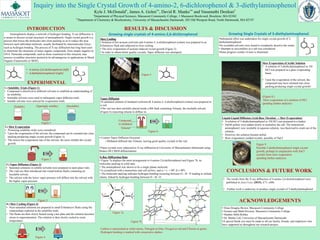
CRYSTAL_POSTER_FINAL_AMINOPHENOLS
- 1. Inquiry into the Single Crystal Growth of 4-amino-2, 6-dichlorophenol & 3-diethylaminophenol Kyle J. McDonald*, James A. Golen**, David R. Manke** and Vasumathi Desikan* *Department of Physical Sciences, Massasoit Community College, 1 Massasoit Boulevard, Brockton, MA 02302 **Department of Chemistry & Biochemistry, University of Massachusetts Dartmouth, 285 Old Westport Road, North Dartmouth, MA 02747 Aminophenols display a network of hydrogen bonding. X-ray diffraction is a means to discern crystal structures of aminophenols. Single crystal growth is a process that forces the molecules into close packing so as to reduce the area between each individual molecule, usually facilitated by intermolecular forces such as hydrogen bonding. The process of X-ray diffraction has long been used to determine the structures of many organic compounds, from simple organics to DNA. Particular compounds, such as those examined in this research, may possess crystalline structures posited to be advantageous in applications in Metal- Organic Frameworks or MOFs. INTRODUCTION Figure 7a (Figure 8.) Slow evaporation of a solution of HCl (pending further analysis) EXPERIMENTAL Figure 9 Possible 3-diethylaminophenol single crystal growth, perhaps in conjunction with NaCl crystals from slow evaporation (pending further analysis). RESULTS & DISCUSSION CONCLUSIONS & FUTURE WORK ACKNOWLEDGEMENTS Vapor Diffusion •A saturated solution of methanol (solvent) & 4-amino-2, 6-dichlorophenol (solute) was prepared in a vial. •The vial was then carefully placed inside a RB flask containing Toluene, the insoluble solvent (Figure 6) expecting toluene to diffuse in. X-Ray Diffraction Data • Figure 7a displays the atom arrangement in 4-amino-2,6-dichlorophenol and Figure 7b, its molecular packing in solid state. • The aminophenol was shown to be a single planar molecule. • It crystallized with a monoclinic unit cell (a≠b≠c, and = = 90º, ≠ 90º) • The molecular packing indicates hydrogen bonding occurring between O—H∙∙∙N leading to infinite chains, linked by hydrogen bonding between N—H∙∙∙O. Carbon is represented as white atoms, Nitrogen as blue, Oxygen as red and Chorine as green. Hydrogen bonding is marked with consecutive dashes. Liquid-Liquid Diffusion (Acid-Base Titration → Slow Evaporation) • A solution of 3-diethylaminophenol in 1M HCl was prepared in a beaker. • NaOH pellets were added slowly to neutralize the salt. The neutralized aminophenol, now insoluble in aqueous solution, was theorized to crash out of the solution. • However, the solution became turbid. • Slow evaporation yielded crystals, possibly of NaCl. •Substantial effort was undertaken for single crystal growth of 3- diethylaminophenol. •No available solvents were found to completely dissolve the solute. • Attempts to recrystallize as a salt was considered. •Some progress worthy of note is illustrated. Slow Evaporation of Acidic Solution • A solution of 3-diethylaminophenol in 1M HCl was prepared in a glass evaporating basin. • Upon the evaporation of the solvent, the compound may have oriented into close packing producing single crystal growth! • Dean Douglas Brown, Massasoit Community College • Science and Math Division, Massasoit Community College • Heather Mills-Robles • Dr. Manke Lab, University of Massachusetts Dartmouth •A special thank you must be made to all our family, friends, and employers who have supported us throughout our research project. 1.) Solubility Trials (Figure 1) • Compound is dissolved in different solvents to establish an understanding of its solubility. • Insoluble solvents were used in subsequent vapor diffusion trials. • Soluble solvents were utilized for evaporation trials. 2.) Slow Evaporation • Promising solubility trials were considered. • Upon the evaporation of the solvent, the compound can be oriented into close packing producing single crystal growth (Figure 2). • The slower the evaporation rate of the solvent, the more reliable the crystal growth. 3.) Vapor Diffusion (Figure 3) • Saturated solutions in soluble solvents were prepared in open glass vials. • The vials are then introduced into round bottom flasks containing an insoluble solvent. • The solvent with the lower vapor pressure will diffuse into the solvent with the higher vapor pressure. 4.) Slow Cooling (Figure 4) • Near-saturated solutions are prepared in small Erlenmeyer flasks using the relationships explored in the solubility trials. • The flasks are then slowly heated using a hot plate and the solution becomes closer to supersaturation. The solution is then slowly cooled to room temperature. Figure 2 HEAT COOLING TIME TIME TIME {Soluble} {Insoluble}{Sparingly soluble} TIME Figure 1 Figure 3 Compound in methanol Toluene Figure 5 Slow Cooling • Solution of hot acetone (solvent) and 4-amino-2, 6-dichlorophenol (solute) was prepared in an Erlenmeyer flask and subjected to slow cooling. • The slow evaporation of acetone induced crystal growth (Figure 5). • In order to obtain better quality crystals, Vapor diffusion was attempted. Figure 4 • Counter Vapor Diffusion Occurred – • Methanol diffused into Toluene, leaving good quality crystals in the vial. •These crystals were subjected to X-ray diffraction at University of Massachusetts Dartmouth using Bruker D8 CMOS diffractometer. Figure 7b TIME • 4-amino-2,6-dichlorophenol (left) • 3-diethylaminophenol (right) Growing single crystals of 4-amino-2,6-dichlorophenol Growing Single Crystals of 3-diethylaminophenol Figure 6 • The results from the X-ray diffraction of 4-amino-2,6-dicholorophenol were published in Acta Cryst. (2015), E71, o406. • Further work is underway to produce single crystals of 3-diethylaminophenol